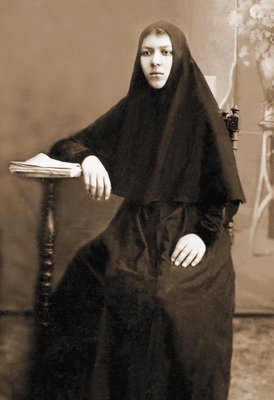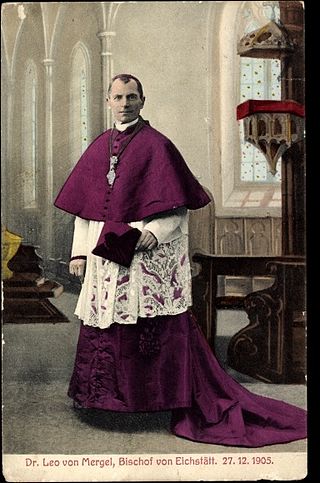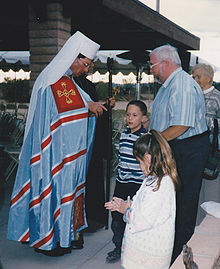
A mantle is an ecclesiastical garment in the form of a very full cape that extends to the floor, joined at the neck, that is worn over the outer garments. Especially in the case of Elijah, it was likely a tallit, a Hebrew garment that housed the fringes still seen today which are also translated at “the hem of His garment” in the New Testament. It is also likely that further ecclesiastical garments were based originally on this one.

Ordination is the process by which individuals are consecrated, that is, set apart and elevated from the laity class to the clergy, who are thus then authorized to perform various religious rites and ceremonies. The process and ceremonies of ordination vary by religion and denomination. One who is in preparation for, or who is undergoing the process of ordination is sometimes called an ordinand. The liturgy used at an ordination is commonly found in a book known as an Ordinal which provides the ordo for celebrations.

The cassock or soutane is a Christian clerical clothing coat used by the clergy and male religious of the Oriental Orthodox Churches, Eastern Orthodox Church and the Catholic Church, in addition to some clergy in certain Protestant denominations such as Anglicans and Lutherans. "Ankle-length garment" is the literal meaning of the corresponding Latin term, vestis talaris. It is related to the habits traditionally worn by nuns, monks, and friars.

The mitre or miter is a type of headgear now known as the traditional, ceremonial headdress of bishops and certain abbots in traditional Christianity. Mitres are worn in the Catholic Church, Eastern Orthodox Church, Oriental Orthodox Churches, the Anglican Communion, some Lutheran churches, for important ceremonies, by the Metropolitan of the Malankara Mar Thoma Syrian Church, and also, in the Catholic Church, all cardinals, whether or not bishops, and some Eastern Orthodox archpriests.

A scapular is a Western Christian garment suspended from the shoulders. There are two types of scapulars, the monastic and devotional scapular; both forms may simply be referred to as "scapular". As an object of popular piety, a scapular serves to remind wearers of their commitment to live a Christian life.

An archdeacon is a senior clergy position in the Church of the East, Chaldean Catholic Church, Syriac Orthodox Church, Anglican Communion, St Thomas Christians, Eastern Orthodox churches and some other Christian denominations, above that of most clergy and below a bishop. In the High Middle Ages it was the most senior diocesan position below a bishop in the Catholic Church. An archdeacon is often responsible for administration within an archdeaconry, which is the principal subdivision of the diocese. The Oxford Dictionary of the Christian Church has defined an archdeacon as "A cleric having a defined administrative authority delegated to him by the bishop in the whole or part of the diocese." The office has often been described metaphorically as oculus episcopi, the "bishop's eye".

Epimanikia are liturgical vestments of the Eastern Orthodox Church and Eastern Catholic Churches. They are cuffs made of thickened fabric, usually brocade, that lace onto the wrists of a bishop, priest, or deacon. There is usually a cross embroidered or appliquéd to the center.
Hegumen, hegumenos, or igumen, is the title for the head of a monastery in the Eastern Orthodox and Eastern Catholic Churches, or an archpriest in the Coptic Orthodox Church, similar to the title of abbot. The head of a convent of nuns is called a hegumenia or igumeni. The term means "the one who is in charge", "the leader" in Greek.
Clerical clothing is non-liturgical clothing worn exclusively by clergy. It is distinct from vestments in that it is not reserved specifically for use in the liturgy. Practices vary: clerical clothing is sometimes worn under vestments, and sometimes as the everyday clothing or street wear of a priest, minister, or other clergy member. In some cases, it can be similar or identical to the habit of a monk or nun.

Panagia, in Medieval and Modern Greek, is one of the titles of Mary, mother of Jesus, used especially in Eastern Catholicism and Orthodox Christianity.
The holy anointing oil formed an integral part of the ordination of the priesthood and the High Priest as well as in the consecration of the articles of the Tabernacle and subsequent temples in Jerusalem. The primary purpose of anointing with the holy anointing oil was to sanctify, to set the anointed person or object apart as qodesh, or "holy".

A kalimavkion, kalymmavchi (καλυμμαύχι), or, by metathesis of the word's internal syllables, kamilavka, is a clerical headdress worn by Orthodox Christian and Eastern Catholic monks or awarded to clergy. An approximate equivalent in the Latin Church is the biretta.

An epanokalimavkion is an item of clerical clothing worn by Orthodox Christian monastics who are rassophor or above, including bishops. It is a cloth veil, usually black, which is worn with a kalimavkion.

A skufia is an item of clerical clothing, a cap, worn by Eastern Orthodox, Eastern Lutheran and Eastern Catholic monastics or awarded to clergy as a mark of honor.

An apostolnik or epimandylion is an item of clerical clothing worn by Eastern Orthodox and Byzantine Catholic nuns. It is a cloth veil that covers the head, neck, and shoulders similar to a khimār form of hijab worn by Muslim women, usually black, but sometimes white. It is sometimes worn with a skufia.

Choir dress is the traditional vesture of the clerics, seminarians and religious of Christian churches worn for public prayer and the administration of the sacraments except when celebrating or concelebrating the Eucharist. It differs from the vestments worn by the celebrants of the Eucharist, being normally made of fabrics such as wool, cotton or silk, as opposed to the fine brocades used in vestments. It may also be worn by lay assistants such as acolytes and choirs. It was abandoned by most of the Protestant churches that developed from the sixteenth-century Reformation.

A religious habit is a distinctive set of religious clothing worn by members of a religious order. Traditionally some plain garb recognizable as a religious habit has also been worn by those leading the religious eremitic and anchoritic life, although in their case without conformity to a particular uniform style.
Stéphanos II Ghattas was an eparch of the Coptic Catholic Church. From 1986 to 2006 he served as the Coptic Catholic Patriarch of Alexandria. He was also a Cardinal. His canonization process has been initiated.
The degrees of Eastern Orthodox and Eastern Catholic monasticism are the stages an Eastern Orthodox monk or nun passes through in their religious vocation.

The koukoulion is a traditional headdress worn by monks and certain patriarchs in Eastern Christianity.

















